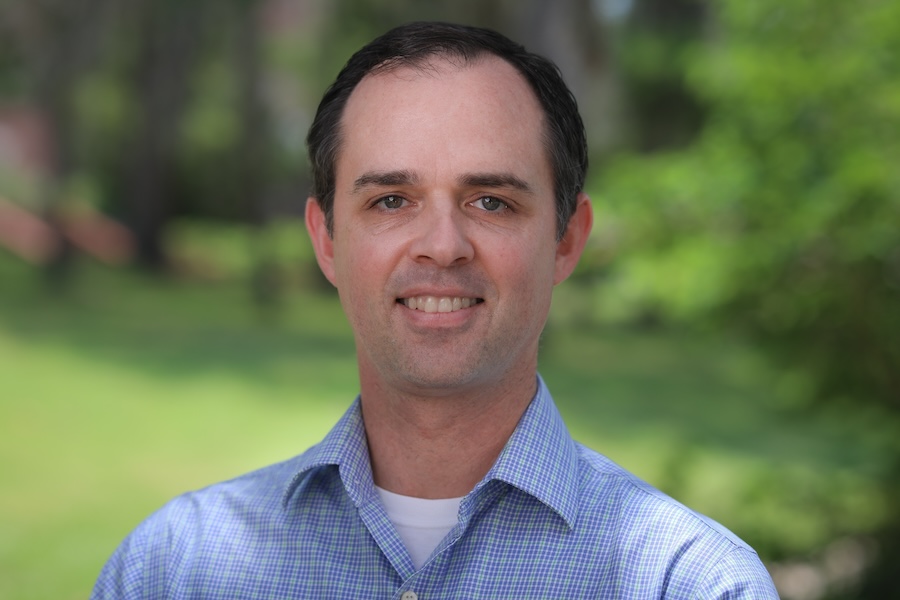Faculty Spotlight: Christopher Holmes

Christopher Holmes is an associate professor in the Department of Earth, Ocean and Atmospheric Science, part of Florida State University’s College of Arts and Sciences. After coming to FSU in 2014, Holmes founded FSU’s Atmospheric Chemistry and Global Change Research Group, which uses computer models to study the impacts of air pollution and greenhouse gases, including carbon dioxide and methane. Holmes was named a NASA New Investigator program member from 2016 to 2019, and he earned a National Science Foundation Faculty Early Career Development Program, or CAREER, award in 2019, one of its most prestigious awards for early-career researchers.
Tell us a little about your background, where you’re from and what brought you to FSU.
I'm an atmospheric scientist who studies air pollution and greenhouse gases. In 2010, I earned a doctoral degree in earth and planetary science from Harvard University and began as a research scientist at the University of California, Irvine. I came to FSU in 2014 and have been teaching meteorology and atmospheric science since.
Can you break down your areas of research for us?
My research group and I use computer coding to build 3D models of air pollution and greenhouse gases on both regional and global levels. Then we use observations from satellites, ships, and aircrafts to understand how well our predictions perform. The goal of our research is to better anticipate periods of poor air quality and how greenhouse gases may change in the future.
What do you want the public to know about your research?
Scientists are working hard to understand where air pollution is coming from and what regional and global factors contribute. Scientists are also studying the effects of air pollution, such as where it goes, how it's removed from the atmosphere and its impacts.
Tell us about your research that indicated common satellite imaging technology underestimated the number of fires in Florida.
Prescribed fires are common in the winter and early spring to reduce the risk of dangerous wildfires and improve forest habitats in the Southeast United States. We determined many of these fires were not accounted for because satellites, a primary tool used to study air pollution, were unable to detect many of these smaller eastern fires.
It’s important to recognize that these prescribed fires have major benefits in reducing the risk of wildfires. My goal as a scientist is to help land managers keep the negative environmental impacts of prescribed fires as minimal as possible.
Tell us about the data set SynFlux.
SynFlux is a data set my research group and I developed to monitor how much ozone goes into vegetation across the United States. Although ozone in the atmosphere’s stratospheric layer protects us from the sun’s ultraviolet radiation, ozone at the Earth’s surface can cause respiratory distress and damage crop production. Annually, worldwide ozone pollution reduces global grain yields by approximately 15 percent and costs about $20 billion in lost crop yields. Our goal is to better understand how much ozone vegetation uptakes and how much plants are injured by it.
Tell me about the CAREER award you earned from the National Science Foundation in 2019.
This CAREER award gave me funding to continue my research on the impacts of ozone air pollution on vegetation in the biosphere for five years. This award has enabled my research group and me to lead international modeling exercises to understand how well our group can predict atmospheric ozone patterns and improve the way other research groups make predictions. My group and I are currently working to analyze the results from this research.
From 2016-2019, you were part of the NASA New Investigator Program in Earth Science, which supports research initiatives for individuals that recently earned their doctoral degree. What was being a part of this program like?
I have immensely enjoyed working with the NASA atmospheric chemistry community. Through this program I worked with both NASA and the National Oceanic and Atmospheric Administration to conduct large scale aircraft-based field experiments. In 2019, I was part of the NASA and NOAA Fire Influence on Regional to Global Environments and Air Quality, or FIREX-AQ, campaign.
This campaign used three aircrafts that flew through smoke plumes from both large western wildfires and small eastern prescribed fires. We were able to measure what chemicals the fires emitted close to the fire and monitor the changes downwind. We flew over some of the biggest wildfires burning in the country in 2019, including the Williams Flats Fire in Washington and the Sheep Fire in Idaho.
Tell us about what it means to earn teaching and course-related awards as an early-career faculty member.
I enjoy the opportunity to work with our smart and talented undergraduate students. In all the courses I teach, I incorporate data analysis and computer programming to give students useful skills for many career paths. It’s also important to get students to talk to each other in the classroom so they can exercise their ability to explain. When students disagree, I aim to create conversations where students can try and convince each other of the right answer.
What is your best memory so far from working at FSU?
Sometimes the most fun classes begin with students asking questions that lead the discussion away from my original plan for the class. These types of discussions can teach students a lot because their interests mix with topics covered by the course.
If your students only learned one thing from you (of course, hopefully they learn much more than that), what would you hope it to be?
I want my students to master the basics of physics and chemistry as well as realize that these basic science principles can be used to explain the world around us. A lot of the challenges scientists encounter are about making basic scientific knowledge relevant to people’s daily lives. It's also important to have input from lots of people and communities because it can lead us to find results in unexpected places.

